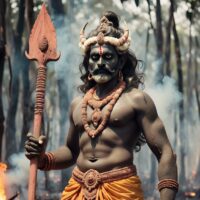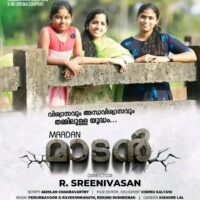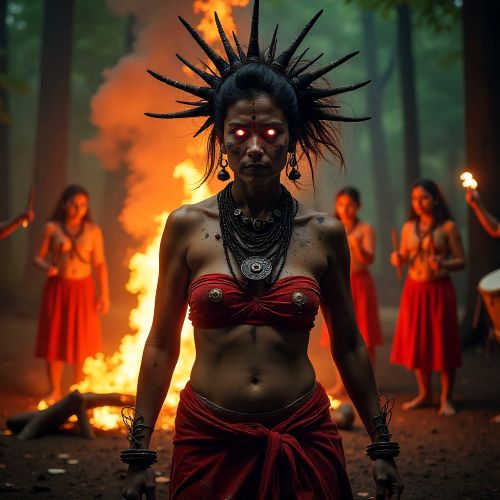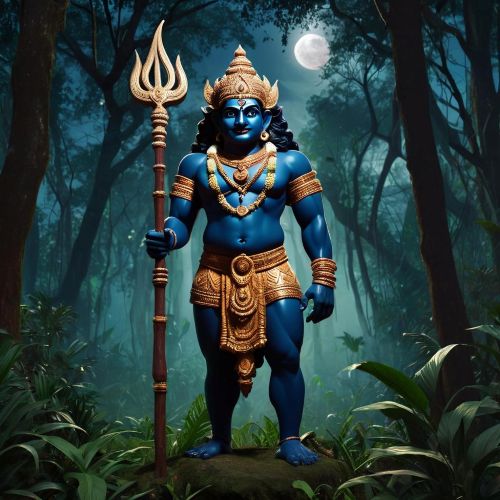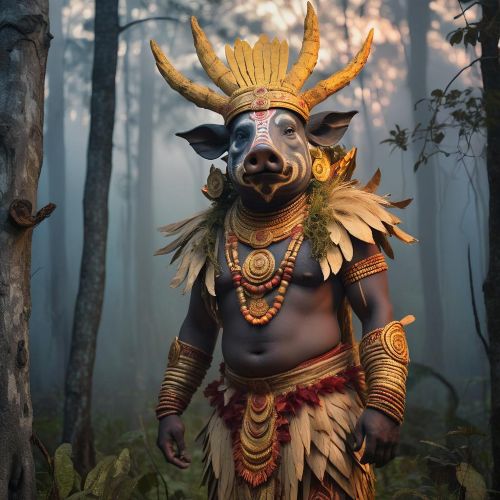Sudalai Madan : Guardian of Cremation Grounds
Listen
At a glance
| Description | |
|---|---|
| Origin | Indian Mythology |
| Classification | Spirits |
| Family Members | Madathi (Wife) |
| Region | India |
| Associated With | Cremation Grounds, Protection |
Sudalai Madan
Introduction
Sudalai Madan, also called simply Madan, is one of the most important guardian deities in Dravidian folk religion. His name means “chief of the cremation ground,” reflecting his close association with death, spirits, and the power of transformation. Unlike Sanskritized Hindu gods, Sudalai Madan belongs to the native Tamil folk pantheon, where he functions as a kaval deivam (protector deity) safeguarding villages from malevolent forces.
The worship of Sudalai Madan is strongest in Tamil Nadu and southern Kerala, though his presence has also spread among Tamil communities overseas in Sri Lanka, Malaysia, and other parts of the world. He is considered a fierce but benevolent deity, embodying both the fear of destruction and the assurance of protection. Oral traditions, local festivals, and ritual practices continue to keep his worship alive, making Sudalai Madan a vital part of South Indian cultural identity.
Physical Traits
The imagery of Sudalai Madan is designed to evoke awe and reverence. Traditionally, idols were sculpted from lime and sand paste, reflecting the temporary, organic nature of folk shrines. In modern times, however, granite idols are increasingly installed, particularly to facilitate abhishekam rituals with water, milk, turmeric, and sandal paste.
Sudalai Madan is usually depicted with a fierce expression, smeared with ash, and adorned with rudraksha beads. His statues are often shown holding protective weapons like tridents, swords, bows, or knives, symbolizing his role as a warrior deity. Horses are common motifs in his shrines, indicating his speed in protecting devotees. Unlike Brahminical temples with sanctums and towers, Sudalai Madan shrines are open structures, sometimes without roofs, emphasizing accessibility and constant watchfulness. The open-air temples reinforce his identity as a deity unconstrained by ritual purity rules.
Family
In mythological accounts, Sudalai Madan is described as a son of Shiva and Parvati. His origin is tied to fire and divine energy: one legend recounts that Parvati longed for a child, and Shiva guided her to retrieve a spark from the underworld. That spark became a formless mass, which Brahma shaped into a boy. Because he emerged from the flame (sudar) and was initially shapeless, he was named Sudalai Madan.
Parvati fed the child amrita, the nectar of immortality, but his appetite soon turned towards solid food. He began consuming corpses and the remnants of cremation grounds, an act that both horrified and impressed the gods. Shiva finally sent him to earth, decreeing that he would protect mortals in exchange for offerings of food and drink.
Alternative myths mention multiple births: in one, Sudalai Madan was born with two siblings, Sudalai Pechi and Sudalai Mundan; in another, he emerged along with 20 other Madans during a yagna commanded by Shiva. Despite these variations, his myth consistently positions him as a divine being closely tied to death and the earth, while also acting as a guardian to humans.
Although often mistakenly paired with a consort named Madathi, most traditions regard Sudalai Madan as unmarried. Instead, he is associated with companion spirits and local goddesses such as Pechiamman and Vanapechi, who appear in shrines near his temples.
Other names
Regional variations of his worship have produced many titles for Sudalai Madan. He is also known as Sudalai Maadan, Sudalai Mada Sami, Sudaleshwaran, Madasamy, and Maasana Muthu. In some places, he is addressed as Mundan Sami, Irulappa Sami, or Mayandi. These different names emphasize his many roles—as a fierce guardian, a cemetery ruler, and a protective household spirit. Some traditions also call him Siva Sudalai Madan, linking him directly to Shiva’s lineage.
The diversity of names reflects the oral and localized nature of his cult. Each village shapes his identity slightly differently, but the core remains the same: a powerful protector who channels the raw energy of death into safety and prosperity for his devotees.
Powers and Abilities
Sudalai Madan’s powers come from his unique dominion over cremation grounds and his divine ancestry. His title itself suggests mastery over spirits of the dead, making him the one who keeps restless souls in check and shields the living from their harm.
As a kaval deivam, he is invoked to ward off epidemics, evil spirits, and misfortune. Unlike deities tied to astrological rituals or distant cosmic concerns, Sudalai Madan is seen as a direct and immediate presence in village life. He is the guardian of the kodimaram (temple flagstaff), symbolizing his watch over sacred spaces.
His worship is also distinctive for its offerings. Devotees bring cooked meat, birds, goats, and arrack, honoring his taste for hearty, earthly food. Unlike mainstream Vedic rituals that emphasize vegetarian offerings, his acceptance of meat signifies his closeness to the realities of village life and death.
Communication with him often occurs through oracles, where chosen individuals, possessed during festivals, speak his words to the community. These oracular traditions allow Sudalai Madan to remain an active part of decision-making and problem-solving within the village. Rituals like Mayana Puja, held in cremation grounds, further underline his association with liminal spaces and his ability to transform fear into protection.
Modern Day Influence
Sudalai Madan continues to hold immense cultural significance in contemporary Tamil Nadu and Kerala. His temples remain community-centered, often outside the control of larger institutional religious authorities. In these spaces, his worship sustains oral storytelling, folk music, drumming, and ritual theater, preserving traditions that might otherwise fade.
Migration and globalization have also carried his worship beyond India. Tamil diaspora communities in Sri Lanka, Malaysia, and French territories such as Réunion maintain Sudalai Madan shrines, adapting his rituals to new cultural contexts while preserving their essence.
At the same time, the process of Sanskritization has influenced his worship. In districts like Kanyakumari, older folk shrines are being rebuilt with gopurams and granite idols, and rituals are increasingly formalized with Vedic ceremonies. While this brings him closer to mainstream Shaivism, some argue it dilutes the folk identity that makes Sudalai Madan unique.
Animal sacrifice, once a common feature of his worship, has declined in many temples due to social change and legal restrictions. However, in several rural areas, it persists as an essential part of honoring his protective powers. Despite these transformations, his role as a protector of families and villages remains unchanged.
More recently, Sudalai Madan has gained attention in digital spaces. Researchers, cultural enthusiasts, and local devotees are sharing his stories through blogs, YouTube videos, and social media, ensuring that his mythology is preserved for new generations. His image also appears in folk art, plays, and even modern cultural festivals, where he symbolizes resilience, guardianship, and the continuity of Tamil traditions.
Ultimately, Sudalai Madan embodies the living bridge between the sacred and the everyday. His fierce guardianship, unique rituals, and deep-rooted presence in Tamil folk life ensure that his legacy continues to thrive, both in rural temples and in the global Tamil diaspora.
Related Images
Source
Wikipedia contributors. (n.d.). Sudalai Madan. Wikipedia. Retrieved September 15, 2025, from https://en.wikipedia.org/wiki/Sudalai_Madan
Wisdom Library. (n.d.). Madan: Significance and symbolism. Retrieved September 15, 2025, from https://www.wisdomlib.org/concept/madan
Sudalai Madan- A guardian deity in Tamilnadu – Hindu Scriptures. (2019). https://hinduscriptures.com/sudalai-madan-a-great-guardian-deity-in-tamil-nadu/
Frequently Asked Questions
What is lorem Ipsum?
I am text block. Click edit button to change this text. Lorem ipsum dolor sit amet, consectetur adipiscing elit. Ut elit tellus, luctus nec ullamcorper mattis, pulvinar dapibus leo.
What is lorem Ipsum?
I am text block. Click edit button to change this text. Lorem ipsum dolor sit amet, consectetur adipiscing elit. Ut elit tellus, luctus nec ullamcorper mattis, pulvinar dapibus leo.
What is lorem Ipsum?
I am text block. Click edit button to change this text. Lorem ipsum dolor sit amet, consectetur adipiscing elit. Ut elit tellus, luctus nec ullamcorper mattis, pulvinar dapibus leo.
What is lorem Ipsum?
I am text block. Click edit button to change this text. Lorem ipsum dolor sit amet, consectetur adipiscing elit. Ut elit tellus, luctus nec ullamcorper mattis, pulvinar dapibus leo.
What is lorem Ipsum?
I am text block. Click edit button to change this text. Lorem ipsum dolor sit amet, consectetur adipiscing elit. Ut elit tellus, luctus nec ullamcorper mattis, pulvinar dapibus leo.


